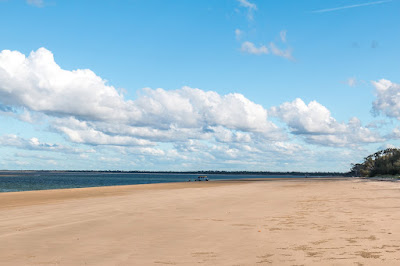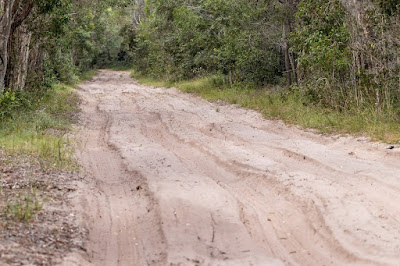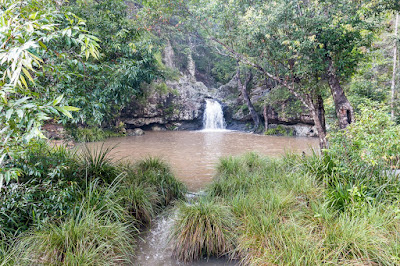 |
| Beach in front of Burrum Point Camping Area |
Burrum Point Camping Area is only a short drive from Woodgate. The road in is sandy and has some narrow sections.
 |
| The sandy drive in to Burrum Point Camping Area |
The campground has a remote and peaceful atmosphere but has surprisingly good facilities. There are flush toilets and water available.
 |
| Our campsite at Burrum Point Camping Area |
Campers are asked not to erect there own individual showers on their sites so as to protect the environment. Indoor and outdoor showers have been installed so that the disposal of soapy water can be controlled.
 |
| Indoor showers at Burrum Point Camping Area |
Before the entry to the campground there is a 4WD access point to the beach. Other campers used this access to drive down to the beach to fish. The campers next to us got quite a surprise to catch a large mud crab on their fishing line.
 |
| 4WD access to the beach in front of Burrum Point Camping Area |
Resident goannas and brush turkeys patrol the campground so particular care needs to be taken with the storage of rubbish.
 |
| Sand Monitor |
 |
| Australian Brush Turkey |
We spotted some Grandmothers Cloak moths in the amenities block.
 |
| Grandmother's Cloak Moths (flash photography). |
We really enjoyed watching a couple of families of White-bellied Sea-Eagles cruise up and down the beach. Every time these huge birds flew past a section of the beach a smaller bird bravely came out and tried to chase them away. We couldn't tell with the naked eye what kind of bird it was but when we examined our photos we realised that it was a peregrine falcon.
 |
| White-bellied Sea-Eagle |
 |
| White-bellied Sea-Eagle |
 |
| Peregrine Falcon |
Details for Burrum Point Camping Area:
Where: Burrum Coast National Park. 356 km north of Brisbane via Gympie, Maryborough and Woodgate. Follow signs from Woodgate. From Walkers Point Road turn left onto Campground Road.
Access: Campground Road is sandy. Hema lists it as medium 4WD and National Parks QLD signposts the road as "high clearance 4WD, not suitable for caravans". The campground is listed as " high clearance 4WD's and trailers only. Caravans and buses are not recommended." Wet weather can restrict access due to flooding.
Booking & Fees: Book online. $6.35 per adult per night. Specific site number allocated when booking.
Sites: There are 13 individually numbered sites. Sandy surface. The sites are mostly small. There are bollards defining the sites but you can park on the site next to your tent or camper trailer.
Facilities: Drinking water taps, cold showers (inside and outside), flush toilets. The indoor showers are plumbed but there is also provision for BYO canvas shower bags in the shower cubicles. We had Telstra phone reception. There is excellent WiFi reception at the seat at the end of the beach access.
Prohibitions: You must use the showers provided; don't erect your own eternal shower or use soap on your site. Domestic animals are not permitted anywhere in Burrum Coast National Park. Domestic animals are not even allowed in vehicles in the national park. No generators. No open fires.
Wildlife we saw in Burrum Coast National Park: Eastern Grey Kangaroo, Burton's Snake Lizard, Copper tailed Skink, Lively Skink, Bats, Feral pig tracks. Butterflies: Large Grass Yellow, Varied Eggfly, Swamp Tiger, Purple Crow, Brown Ringlet, Evening Brown, Skippers. Moths: Grandmothers Cloak, Magpie Moth. Birds: White-bellied Sea-Eagle, Peregrine Falcon, Red Goshawk, Black Kite, Brahminy Kite, Whistling Kite, Australian Brush Turkey, Grey Butcherbird, Pied Cormorant, Great Cormorant, Fan-tailed Cuckoo, Shinning Bronze Cuckoo, Black-faced Cuckoo-shrike, Radjah Shelduck, Bar-shouldered Dove, Spangled Drongo, Little Egret, Grey Fantail, Little Friarbird, Noisy Friarbird, White-faced Heron, Blue-faced Honeyeater, Lewin's Honeyeater, Scarlet Honeyeater, Laughing Kookaburra, Scaly-breasted Lorikeet, Rainbow Lorikeet, Masked Lapwing, Noisy Miner, Mistletoebird, Rainbow Bee-eater, Silver Gull, Grey Shrike-thrush, Silvereye, Black-necked Stork, Golden Whistler, Rufous Whistler, Willie Wagtail, White-breasted Woodswallow.



























































